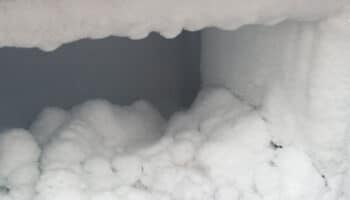It might not be leftovers from that work potluck that are making your fridge smell. Odors coming from your fridge when the door is shut are coming from the fridge itself.
Getting rid of these bad smells does more than just freshen up your kitchen. Those bad fridge smells are being caused by bacteria that can spoil your food or worse. Cleaning your fridge promotes fresh scents and good health.
The bad smell coming from outside your fridge is most likely coming from the drain pan. These bad odors can also be caused by a coolant leak, a pest problem, or another kind of cleaning issue. Getting rid of these bad smells is about safety as much as it is about having a clean kitchen.
Don’t spend another second dealing with that fridge funk! Let’s get started.
What You’ll Need
We’ve put together a guide that is easy and accessible for everyone. You won’t need any specialized tools to get the job done. You’ll just need a few household tools and cleaning supplies to remove any bad odors from your fridge.
Here’s what you’re going to need.
- Screwdriver set
- Rags
- Cleaning solutions
- Dish soap
How to Get Rid of Bad Smells Outside Your Fridge
We’re starting our tips for getting rid of odors outside your fridge with the most likely culprits first. We will be working our way through more complicated fixes and rarer sources of bad smells.
#1 Clean Your Drain Pan
Did you know that your fridge has a drainage pan?
Excess moisture builds up in your fridge, and it needs to go somewhere. Rather than having it pool up inside your fridge, it’s expelled to a drainage pan on the bottom of your fridge.
Your drainage pan will be located in a different position depending on which model of fridge you own. Your owner’s manual should tell you not only where the drainage pan is located, but also how you can remove it. Your owner’s manual will also give you tips on how to clean it.
Here’s a general guide for removing and cleaning a drain pan.
- Unplug your fridge
- Pull your fridge away from the wall
- Remove the grate on the bottom of the back of the fridge
- You should be able to freely pull out your drainage pan, but it might be secured with a screw
- Wash your drainage pan in warm soapy water to get rid of any bacteria or mold
- Dry your pan
- Reinstall your drainage pan
#2 Is the Fridge New?
It’s common for a brand new fridge to come with its own awkward smells. These aren’t typically an issue, and they go away on their own in time.
Your brand new fridge has likely spent most of its life wrapped up in a factory or warehouse waiting to arrive and your kitchen. It’s going to have some musty smells from its time sitting around in the warehouse. It might also have a few smells left over from being assembled on the factory line.
If you just bought your fridge, and it has some awkward smells, these will typically air out in a few days.
If it’s been over a week and your fridge still has that awkward “new fridge” funk, then it’s time to try some more fixes.
#3 Have You Done Any Remodeling Lately?
Sometimes the smell isn’t coming from your fridge at all. How can this be?
Your fridge exhausts a lot of hot air. If you ever felt warm air coming from the side or the back of your fridge, this is the normal exhaust that your fridge puts out. This exhaust and kick up smells from recent home improvement projects.
If you smell paint, adhesives, or that sawdust smell, these can be caused by a home improvement project near your fridge.
Keep in mind that this only applies to projects immediately in the area of your fridge. We’re talking things like new cabinets are replacing the tiling on your kitchen floor. The home improvement projects on the other side of your house won’t be impacting the smell on your fridge.
#4 Check for Rodents or Insects
Now we’re getting into some less fun solutions. These are more serious problems with your fridge that often involve calling on professional help.

Your fridge can be a moist environment that is loaded with food debris. This is an ideal environment for household pests like cockroaches and rats. An awkward smell coming from underneath your fridge could be a sign that these uninvited guests have set up shop underneath your fridge.
If you start noticing dead insects, rat droppings, or any other signs of a pest invasion, you should reach out to your local pest control experts. They will be able to quickly handle a pest problem and get your kitchen smelling fresh again.
#5 Is the Condenser Fan Running?
Is your condenser fan running? No? Well, you might have found the cause for your fridge’s bad odor!
All jokes aside, your condenser fan can be causing those bad smells from behind your fridge.
The condenser fan supplies cool air to the condenser coils. It also exhausts hot air. If the condenser fan fails, the ambient air around your fridge starts to overheat and produce some bad smells.
Here’s how to change that fan motor.
- Unplug your fridge
- Safely slide the fridge away from the wall. This typically takes two people
- Unscrew the access panel on the back of the refrigerator. You might need to also remove a water intake line in the process
- Unscrew the fan motor from its housing
- Unplug the fan motor
- Plug the new fan motor in and screw it back into the housing
- Reattach the access panel and any other lines you had to take apart
- Slide your fridge back into place
- Plug your fridge in and make sure that you can hear the new motor running

The specifics for changing out your condenser fan will change based on the model of fridge that you own. Your manufacturer’s manual should tell you more about your condenser fan.
If you want to get any replacement part – or see how much one would cost – click to enter your model number in the search bar below. Our partners at AppliancePartsPros stock almost every part with free guides on how to install them.

#6 Clean Those Condenser Coils
The condenser coils themselves are also often a source of bad smells.
The condenser coils are located on the bottom of the fridge or on the back. They are supposed to supply coolant throughout your fridge and keep temperatures low. They also happen to be dust magnets.

You should make cleaning off your condenser coils part of your regular spring cleaning. This will prevent foul-smelling dust and debris from clinging to your condenser coils. The condenser coils can get very hot which means that they’ll be heating up any bad odors that stick to them.
- Unplug your fridge and let the coils cool down
- Dust off the condenser coils
- Plug your fridge back in
Be gentle when cleaning your condenser coils because they can be surprisingly easy to damage.
#7 What About Ammonia and Chemical Smells?
Now we’re getting into the two most serious causes of bad smells coming from the outside of your fridge.
If you happen to notice any chemical smells, it could be caused by a coolant leak. Your fridge uses a few toxic compounds to stay cool. These are perfectly safe when contained within the fridge and condenser coils. However, if there is a leak, one of the easiest ways to tell is the smell.
If you smell an odor that is similar to ammonia near your fridge, it could be a sign of a coolant leak. Some people also say that refrigerator coolants have a sweet and musty smell.
This is typically coupled with a sudden drop in performance. If you notice the smells and also noticed that your fridge is struggling to stay cool, you could have a leak on your hands.
Contact an appliance repair technician immediately. These leaks can be dangerous and can only be fixed by a professional.
#8 Burning Smells from the Back of Your Fridge
The only time you should notice any burning smells around your fridge is when you are desperately trying to salvage that botched turkey roast.
Burning smell from around your fridge could be a sign of a fire. This is commonly caused by dust building up on the condenser coils and heating up to the point where it starts to smoulder.
If you smell burning coming from the outside of your fridge, you should unplug it immediately. Inspect the back of the fridge for any signs of a fire and proceed accordingly. You’re probably just going to have to clean off the dust from the condenser coils, but it never hurts to have a fire extinguisher on hand.
What Causes Bad Smells Behind Your Fridge?
Bad odors from inside of your fridge are typically caused by mystery meat and neglected leftovers. However, a bad smell coming from outside of your fridge is a bit more difficult to diagnose.
Most of the time, this bad smell will be coming from a dirty drainage pan. These pans can develop bacterial and mold growth over time and need to be regularly cleaned.
These bad smells can also be caused by problems with the condenser coils. In the worst-case, a bad smell coming from your fridge is caused by a coolant leak and that needs to be fixed immediately by a professional.
Getting Rid of Bad Smells From Behind Your Fridge: Conclusion
Now you’re ready to tackle any bad smell that’s coming from the outside of your fridge. Cleaning out the drainage pan is going to be the easiest way to tackle a bad smell from underneath your fridge. You might also need to contact pest control or get an appliance repair technician to inspect your condenser coils for a leak.
Don’t let a bad smell from your fridge keep your kitchen down. Check out the other articles below for more common fridge repair tips!







